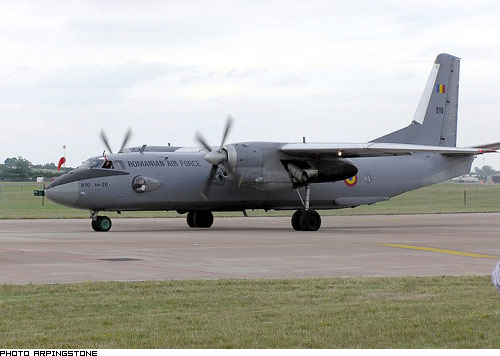An-26 Curl
Summary
| Category | Military Transport Aircraft |
| Origin country | 🇨🇳 Ex-USSR |
| Manufacturer | Antonov |
| First flight | 21 May 1969 |
| Year introduced | 1969 |
| Number produced | 1403 units |
| Average unit price | $12 million |
Description
While the An-24T tactical transport had proven successful in supporting Soviet troops in austere locations, its ventral loading hatch restricted the handling of cargo, and in particular vehicles, and made it less effective than hoped in parachuting men and supplies. As a result, interest in a version with a retractable cargo ramp increased, and the Antonov design bureau decided in 1966 to begin development on the new An-26 derivative, in advance of an official order. In March 1968, the OKB received official permission to begin development. Particular attention was given to the military mission, and the majority of early An-26 production was delivered to the VTA (voyenno-transportnaya aviatsiya).
The An-26 utilizes the An-24 airframe, featuring high-set cantilevered wings and wing-mounted twin turboprops; however, a distinguishing feature is the incorporation of a turbojet engine within the starboard nacelle, serving as both an auxiliary power unit and a source of additional thrust during take-off, alongside long main undercarriage legs. Its most notable feature is the ventral cargo hatch/ramp, which is based on an earlier design and allows the cargo deck to be sealed and pressurised in flight. This ramp could be lowered for vehicle loading or slid forward under the fuselage to allow direct loading from truck beds. Military-specific equipment is integrated into the design, including tip-up paratroop canvas seats, an overhead traveling hoist, bulged observation windows, and parachute static line attachment cables. The aircraft's internal configuration can be rapidly converted from troop transport or freight roles to medical evacuation, accommodating up to 24 stretchers in the latter configuration.
The An-26 possesses a secondary bombing capability through underwing bomb racks, attached to the fuselage both in front of and behind the rear landing gear. The Vietnam People's Air Force utilized this configuration extensively during the Cambodian-Vietnamese War. Similarly, the Sudanese Air Force employed the An-26 in a bombing role during the Second Sudanese Civil War and the conflict in Darfur. Even Russian Forces have conducted training exercises using the An-26 as a bomber.
The An-26 was produced from 1969 to 1986. It made its public debut at the 27th Paris Air Show at Le Bourget where the second prototype, CCCP-26184 (c/n00202), was shown in the static aircraft park. The An-26 has seen extensive operational use in both military and civilian roles across numerous countries. The Afghan Air Force received An-26s in 1977 and by 1986, operated 36 aircraft, employing them for airborne assaults conducted by army commando and parachute battalions, as well as in two military transport squadrons. Beyond its official military engagements, one An-26 was involved in the Purulia Incident in 1995, where arms were airdropped into West Bengal, India. The An-26 is also manufactured without a license agreement in China by the Xian Aircraft factory as the Y-14, later changed to be included in the Xian Y7 series.
Main Variants:
-
An-26: The basic twin-engine tactical transport aircraft, serving as the foundation for subsequent variants.
-
An-26-100: A convertible passenger/cargo aircraft, modified from the original An-26 at the Kyiv plant starting in 1999.
-
An-26 Nel'mo: An arctic surveillance and reconnaissance aircraft equipped with specialized Nel'mo equipment for operations in polar regions.
-
An-26 Pogoda: An aircraft designed for weather control duties, similar to the An-26 Tsiklon but with a simplified equipment test lab.
-
An-26 Polyot: A unique aircraft retrofitted for researching unified air traffic control and monitoring systems throughout the USSR, featuring a comprehensive navigation test lab.
Technical specifications
| Version: An-26 Curl-A | |
|---|---|
| Crew | 2 pilots + 1 WSO + 1 radio operator |
| Operational range | 1,100 km (684 mi) |
| Maximum speed | 540 km/h (336 mph) |
| Wing area | 75 m² (807.3 sqft) |
| Wingspan | 29.2 m (95.8 ft) |
| Height | 8.3 m (27.3 ft) |
| Length | 23.8 m (78.1 ft) |
| Service ceiling | 7,500 m (24,606 ft) |
| Empty weight | 15,000 kg (33,069 lbs) |
| Max. takeoff weight | 24,000 kg (52,911 lbs) |
| Climb rate | 8.0 m/s (26.2 ft/s) |
| Powerplant | 2 x turboprops Ivchenko-Progress AI-24T delivering 900 kgf each |
Current operating countries
| Country | Units | ||
|---|---|---|---|

|
Russia | 115 | |

|
China | 19 | |

|
Nicaragua | 4 | |

|
Uzbekistan | 4 | |

|
Angola | 3 | |
| 🇨🇩 | Congo Democratic Republic | 3 | |

|
Mongolia | 3 | |

|
Syria | 3 | |

|
Chad | 3 | |

|
Belarus | 2 | |

|
Ivory Coast | 2 | |

|
Djibouti | 2 | |

|
Cambodia | 2 | |
| 🇱🇦 | Laos | 2 | |

|
Sudan | 2 | |
| 🇸🇸 | South Sudan | 2 | |

|
Ukraine | 2 | |

|
Vietnam | 2 | |

|
Afghanistan | 1 | |

|
Cameroon | 1 | |

|
Moldova | 1 | |

|
Mali | 1 | |

|
Mozambique | 1 | |

|
Malawi | 1 | |

|
Namibia | 1 | |

|
Romania | 1 | |

|
Serbia | 1 | |

|
Tajikistan | 1 | |

|
Turkmenistan | 1 | |

|
Zambia | 1 | |
All operators
